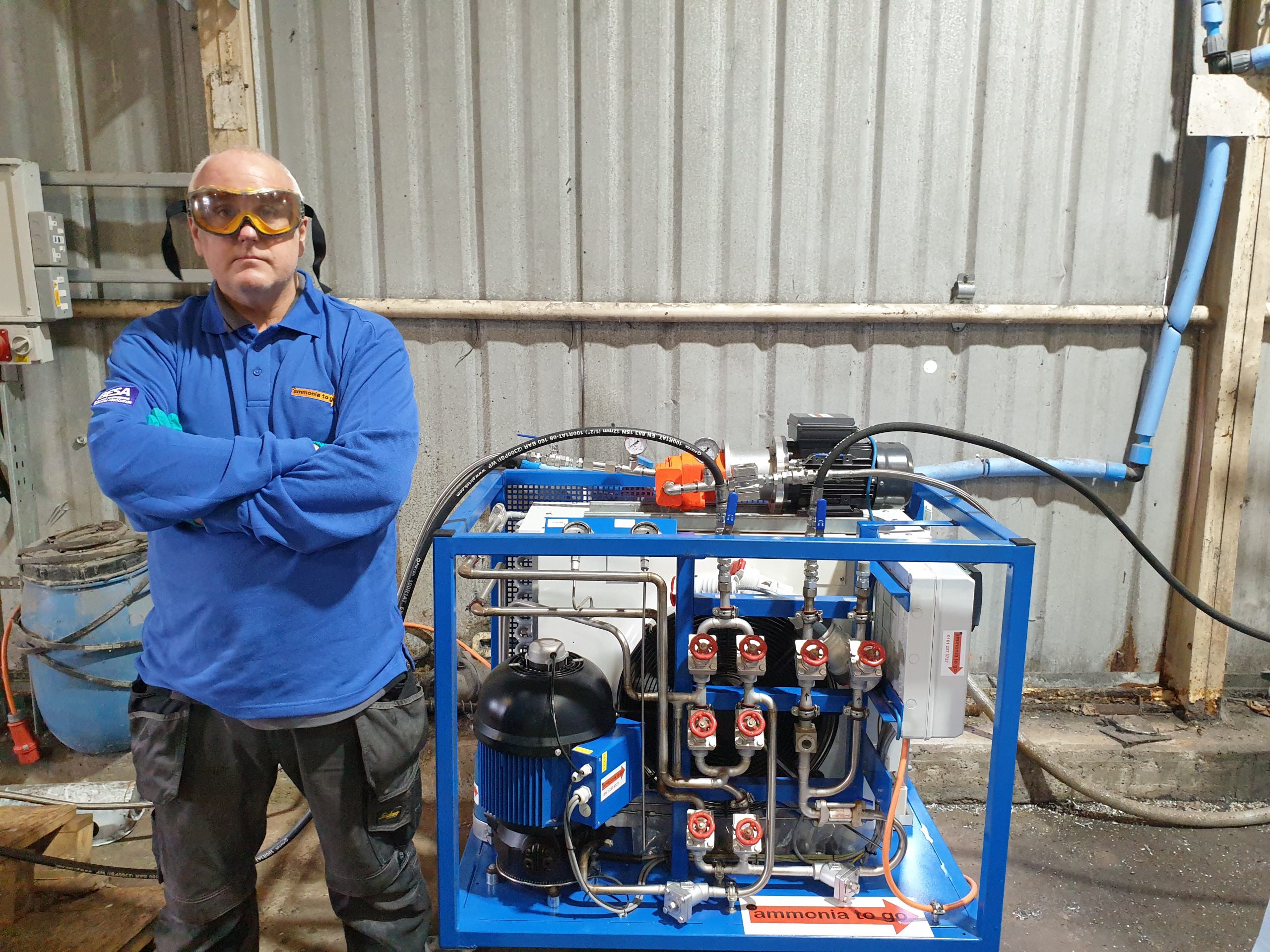
ammonia to go refrigerant recovery
Ammonia refrigerant recovery is available to any customer in the UK. We even have overseas customers in Jeddah and Malaga. We at ammonia to go have state of the art ammonia refrigerant recovery units.
pump out unit
The pump out unit is set up to suck refrigerant vapour from the recovery vessels to drop their internal pressure. This lower pressure assists the transfer pump. The small amount of liquid refrigerant which is condensed in the pump out unit is put back into the plant. When the transfer pump has finished getting the liquid out of the plant, the operation of the pump out unit is reversed and the vapour in the plant is condensed into liquid and then discharged into the recovery vessels.
components
All of the components of the pump out unit are ammonia tested and certified. The certification is kept in a file at Head Office with the design specifications.
compressor
Suction vapour enters the compressor and is discharged as a hot high pressure gas. We use a reciprocating compressor with a sight glass to see the oil level. Oil which is discharged from the compressor goes into an oil separator…
oil separator
This oil separator slows the velocity of the discharge refrigerant by having a larger internal volume than the discharge pipe. Also, the discharge gas is swirled around the inside of the oil separator. This causes the oil to drain to the bottom and the discharge gas to leave the oil separator from the top on the way to the condenser.
compressor oil return
The oil which collects in the bottom of the oil separator is returned to the oil sump in the bottom of the compressor. This oil sump is at low suction pressure and the oil separator is at high discharge pressure. This difference in pressure causes the oil to return to the compressor.
condenser
The condenser has a direct on line 3 phase condenser fan which is operated by a cam switch which is located on the pump out unit’s panel.
high pressure switch
A high pressure switch is connected to the condenser with a ¼” hose. This switch has a manual reset button and forms part of the safety chain which is designed to protect the compressor.
subcooling
The ammonia refrigerant which goes through the condenser is subcooled to below saturation by the air being sucked through the fins by the condenser fan. The fins are used to increase the surface area of the condenser tubes and dissipate more heat.
sight glass
On the outlet from the condenser, we have fitted a sight glass to inspect that the refrigerant has been satisfactorily condensed into a liquid.
check valve
The last component fitted to the pump out unit is the check valve. This valve is a safety feature should anything go wrong with the pump out unit. Only the inlet to the unit would need to be closed in the event of a failure of the unit.

ammonia to go refrigerant transfer pump
Now available to any UK factory- ammonia refrigerant transfer. We had previously only offered this service to our maintenance contact customers.
ammonia to go pump
The design requirements of these pumps mean that they are not available to buy from any supplier. Therefore, we design and build our own pumps using NASA technology…
NASA developed technology
Ammonia is used to cool the international space station. NASA has developed materials that are not affected by the highly toxic and highly corrosive properties of ammonia.
pump build materials
We therefore design and build our pumps using:
- High strength ammonia resistant external casings.
- High tensile internal moving components.
- NASA developed ammonia proof shaft sealing system and casing seal compounds.
pressure temperature relationship
The above materials have been rigorously tested in our laboratory at Head Office to prove they are able to withstand the pressure temperature relationship found in a refrigerating plant. These temperatures can be as low as -40°C and as high as 40°C. The pressure temperature relationship corresponds to the ambient temperature. The higher the ambient temperature, the higher the pressure. Therefore, our transfer pumps can withstand a high inlet pressure.
high capacity
We at ammonia to go know that down time costs you money! Therefore, we offer fast liquid ammonia transfer to get the job done fast!
safety and monitoring
Our ammonia refrigerant hoses are steel braided for extra strength and durability. We use high quality analogue gauges either side of the pump for inlet and outlet pressure monitoring. ¼ turn ball valves and a check valve are fitted to the pump for rapid system shut off. An ammonia resistant sight glass is also used for liquid refrigerant monitoring.
ammonia to go refrigerant disposal
Ammonia refrigerant disposal is now available to any UK customer.
ammonia recycling facility
We are on account and certificated as an authorised agent to sign over ammonia refrigerant to recycling facilities. We have different recycling facilities around the UK which we use depending on where the job is. A dispatch to disposal paper trace is kept in our ammonia refrigerant file at Head Office. This file is available for inspection at any time by auditors or by industry inspection officials.
So, if you are decommissioning your plant or carrying out factory shut down scheduled repairs, you know where to come when you want your ammonia to go…
Read more about ammonia leakage, dispersion and risk assessment at the Institute of Refrigeration and why not check out the Danfoss website for the benefits for industrial refrigeration

© 2025 ammonia to go | 4.02 Langley Building, 53 Dale Street, Manchester, M1 2HH
